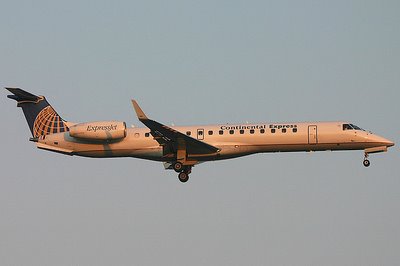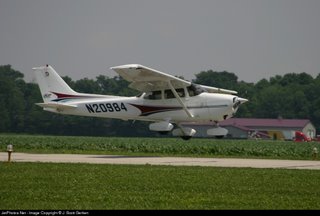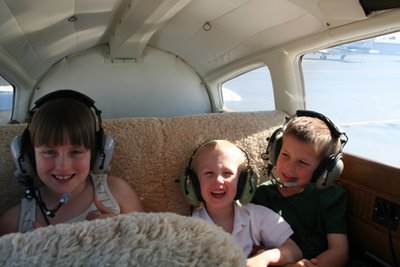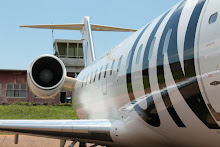Thuderstorms rattled the Phoenix area throughout the night. We had fairly heavy rain, lightning and thunder at our house from Midnight to about 4 a.m. This is unusual weather for October in Arizona. Like I said in an earlier post, this is going to be an El Nino winter, which will bring greater than average rain to Arizona.
When I woke up this morning, I went straight to the computer to check the weather for this morning's flight in the Piper Seneca. First, a quick glance out the window. Doesn't look too good. Second, http://www.aviationweather.gov/ . Not much better. The TAF read something like this:
15012G20 1SM BKN025 OVC050 CB TSRA
TEMPO 1500-1900 24018G25 OVC050CB TSRA+
The pessimist in me went back to bed. The optimist in me thought, weather does change. Might as well get dressed and head to KIWA. Already awake anyway, right?
On the way to the airport, it starts to clear to the East. To the West and North, it still looks pretty nasty. When I get there, I check the weather again. The TAF still has a TEMPO, but I can see that it is clearing rapidly. A quick check of the radar confirms that the weather is trending towards clearing towards the East & West. My instructor isn't here yet, but I decide to go ahead and pre-flight the aircraft. Since I don't have my multi-engine endorsement yet, I'm not PIC yet. Go/no go isn't my call.
My instructor gets to school and I hand him the TAF. He immediately says "no go". Usually, I defer. I would always rather err on the side of caution, but today was shaping up for good flying. Cool, smooth and overcast at about 120.
I say, let me call FSS and get a brief. He agrees and I do. The briefer is in Albuquerque and has the same computer info that we do, so he says it looks bad. I ask my instructor specifically what worries him. He says convective activity. I argue for a call to the tower and he relents. The tower says, no heavy rain or lightning strikes within 30 miles. All convective activity is to the north and west, moving north.
Finally, my instructor agrees to go flying. This is one of those situations where my character flaws work to my advantage. I think I annoyed him to the point that saying yes was better than being sold on it any more. When I want something, I can be as annoying as a yapping Chihuahua...a natural salesman. Again, I usually agree 100% with TAF's, but today was one day that I didn't. The weather was great the entire flight. We encountered some light rain here and there and some steady rain moved in as we did our last touch and go. Cool air, no heating, just as smooth as could be.
Today, we worked on Vmc demonstration, engine out procedures and emergency descents. Vmc is the minimum controllable airspeed in a multi-engine aircraft. A Vmc demo is basically configuring the plane in the most unfavorable way, cutting one engine, props full forward and full power with the operating engine and putting the aircraft right at Vmc by climbing. The signs of reaching Vmc are which ever occurs first: stall warning, stall buffet, full rudder deflection or loss of directional control. Senecas are so stable that Vmc is usually reached by stall, still having directional control. To recover, you then cut the throttle of the good engine, pitch down until you're coordinated and above stall speeds then at Vyse (105MPH in a Seneca) you recover with 15" of manifold pressure on both engines. There's a little more to it, but that's a basic Vmc demo. You're basically showing an examiner that you can maintain directional control of the aircraft at the minimum controllable airspeed in single engine operation.
Then we did a few engine out exercises. When an engine fails, you do two things first. Maintain directional control and pitch for Vyse. Everything else comes second. Then the memory checklist comes in: mixture rich, props forward, throttles forward, flaps 0, gear retract, identify failed engine. Dead foot=dead engine. Whatever foot isn't being used to keep the aircraft coordinated corresponds with the engine that has failed. Trim for directional control. If you're over 1,500' AGL, go to the restart procedure. If you're below 1,500', go to feathering procedure.
For restart: Fuel to cross feed, alternate air on, electric fuel pumps on and magnetos both on.
For feather: Prop to full feather and mixture to cut-off.
These are the memory items. Each procedure has a checklist of non-memory items that follow. I thought I'd never have the checklists memorized. It takes a lot of time for my simple little brain to memorize these check lists. I've seen the memory checklists for the CRJ, and the Seneca is infinitesimal in comparison, so I better stop complaining now and improve my memorization skills.
I did an emergency descent which is simple: close cowl flaps, mixture/prop forward, cut throttles, gear down below 150MPH. Then bank 45 degrees and pitch for 140 miles per hour. Once you get over 30 degrees, the aircraft wants to accelerate rapidly. I had to redo this one to avoid hitting 150MPH and over stressing the landing gear. The second try was just right. Boy it looks steep. All you see is ground. Recover 2,500' AGL.
It was time to return to KIWA for some touch and gos to finish up the lesson. I did 3 touch and go's and 4 landings. Yeah. Four. One short field sucked and I bounced. Now that I know what the problem was, it won't happen again. It takes a little bit to get used to flying a much heavier aircraft. The last two landings were short field too and they were excellent.
Another 1.6 multi. A little bit closer...








